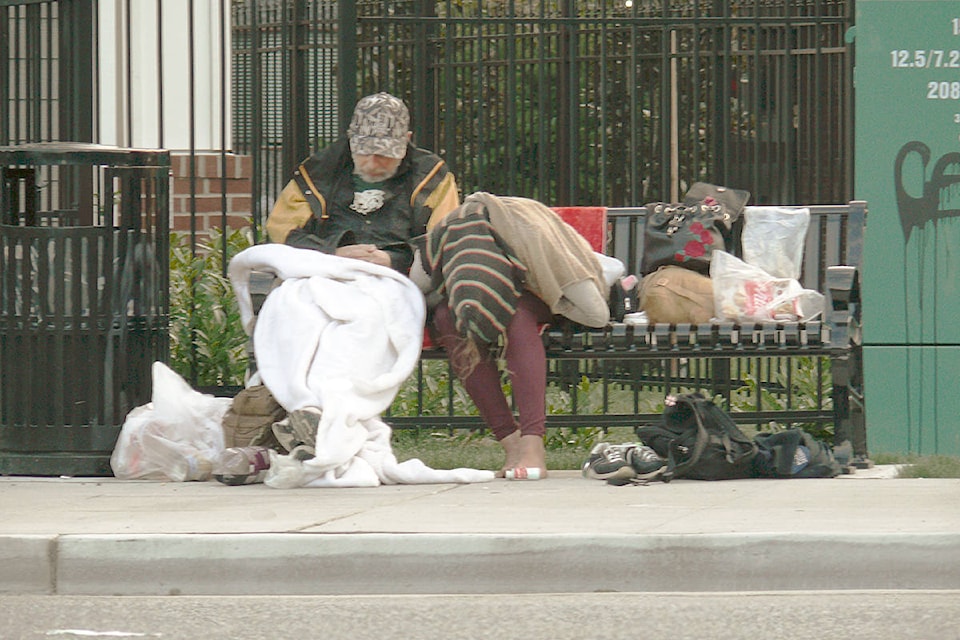More people are living outdoors in Langley than ever, according to a just-released breakdown of numbers from the March Metro Vancouver Homeless Count.
While the overall number of homeless people in Langley City and Township was about the same from the previous count, conducted in 2017 (209 compared to 206 three years ago), the number of so-called “unsheltered” people was up by 26 per cent, according to the final data report issued by the BC Non-Profit Housing Association on Nov. 26, 2020.
Of the 209 counted in the Township and City, more than half, 108, were designated “unsheltered” meaning they stayed outside, defined as “in a makeshift shelter or tent, in a vacant building, in a vehicle, or were staying temporarily indoors (couch-surfing) on the night of March 3.”
That represents an increase of 29 unsheltered from 2017, when 79 were counted.
READ ALSO: More than 200 remain homeless on Langley streets
Fraser Holland, director of homelessness services at Stepping Stone Community Services Society in Langley, said the short-term lease of a Langley hotel early on in the pandemic will help reduce the number the unsheltered.
“It should,” Holland told the Langley Advance Times.
But there are more of them, he noted.
“We’re seeing a lot more new faces,” he commented.
Holland said provincial funding allowed the lease of the Canadas Best Value Inn on 6722 Glover as a temporary shelter until early next year.
Holland explained the single site, which can accommodate about 50 people, was selected “rather than having people scattered over four or five places.”
Kim Snow, of the Kimz Angels outreach assistance agency that distributes food and other necessities to the homeless in Langley, believes if anything, the situation is worse than those numbers indicate.
“They don’t go where we go,” she said of the volunteers who carried out the one-day count, whereas her volunteers are in regular contact with homeless people.
Snow was seeing more and more people living outdoors before the pandemic struck, and she believes the arrival of COVID-19 has made matters even worse.
Before, one homeless person could rent a place and share it with several others to save money, but now, with landlords setting limits on numbers because of COVID-19, there are far fewer options, Snow explained, and the result is more people on the street with no place to sleep.
“We’re seeing people that we have not seen before,” Snow remarked.
“Last week, there were 13 new faces [of people assisted by Kimz Angels].”
READ ALSO: How two 12-year-olds helped the homeless in Langley
Data for the 2020 cont was collected over a 24 hour period to give a snapshot of homeless in the region.
A total of 3,634 people were identified as experiencing homelessness in the Metro Vancouver region during the 2020 count.
The largest numbers of people experiencing homelessness were found in Vancouver (2,095), followed by Surrey (644) and Langley (209).
Indigenous people were over-represented, making up one in four of the homeless counted in Langley.
David Wells, Chair of the Indigenous Homelessness Steering Committee (IHSC) said Indigenous people account for more than a third of all homeless peoples in Metro Vancouver.
“The situation is not improving with more than half of homeless Indigenous Peoples living in an unsheltered situation, which is twice that of non-Indigenous people,” Wells said.
“The situation is even more dire as we all look to take shelter from COVID.”
This was the first homeless count where individuals were asked whether they identified with any racial group or groups.
It found that Black people were 3.7 times more likely to experience homelessness compared to what their presence in the general population would predict.
Latin American and Arab respondents were also over-represented, with Latin Americans being 1.7 times and Arabs 1.3 times more likely to experience homelessness.
More seniors and young people are ending up without places to live, with people 55 and older, represented 24 per cent of the homeless population overall, up from 22 per cent three years ago.
dan.ferguson@langleyadvancetimes.com
Like us on Facebook and follow us on Twitter
